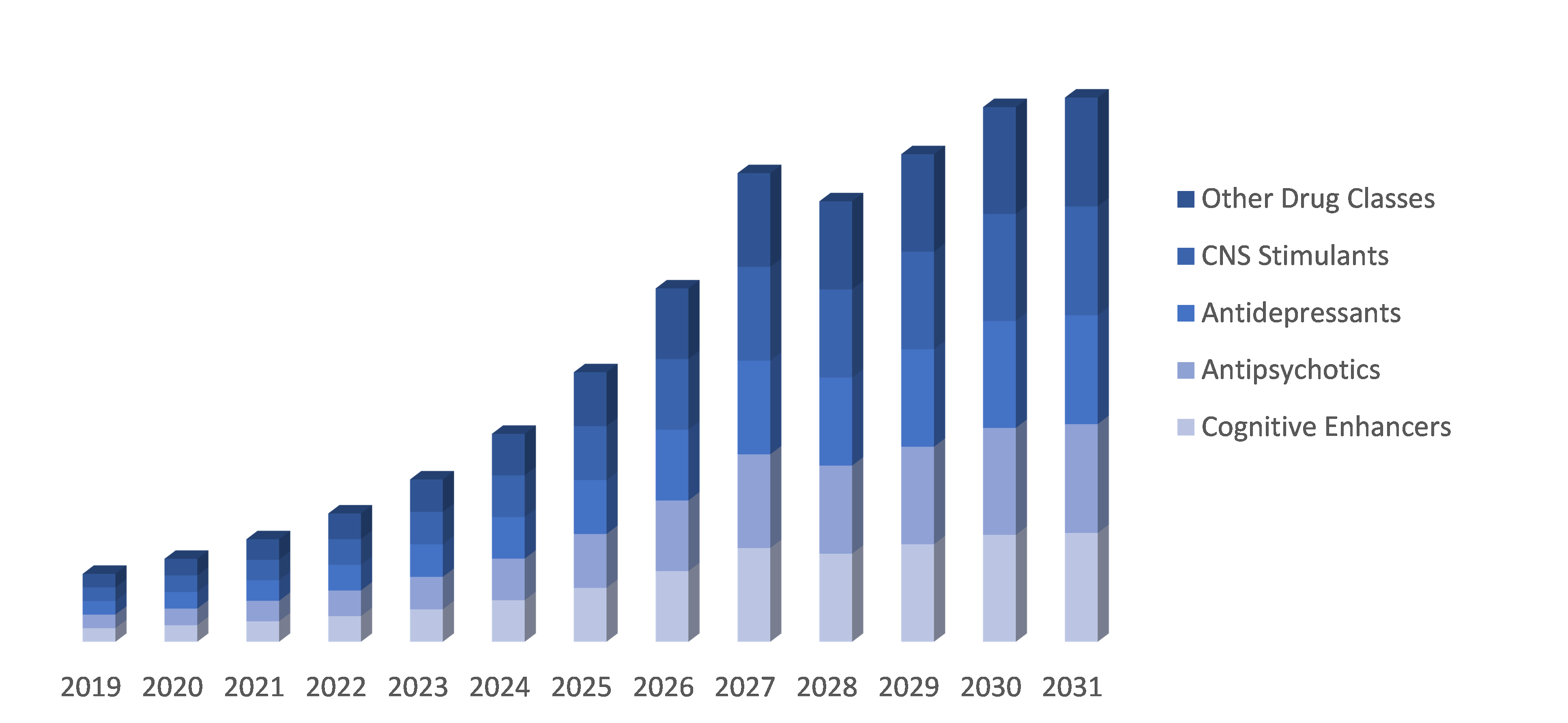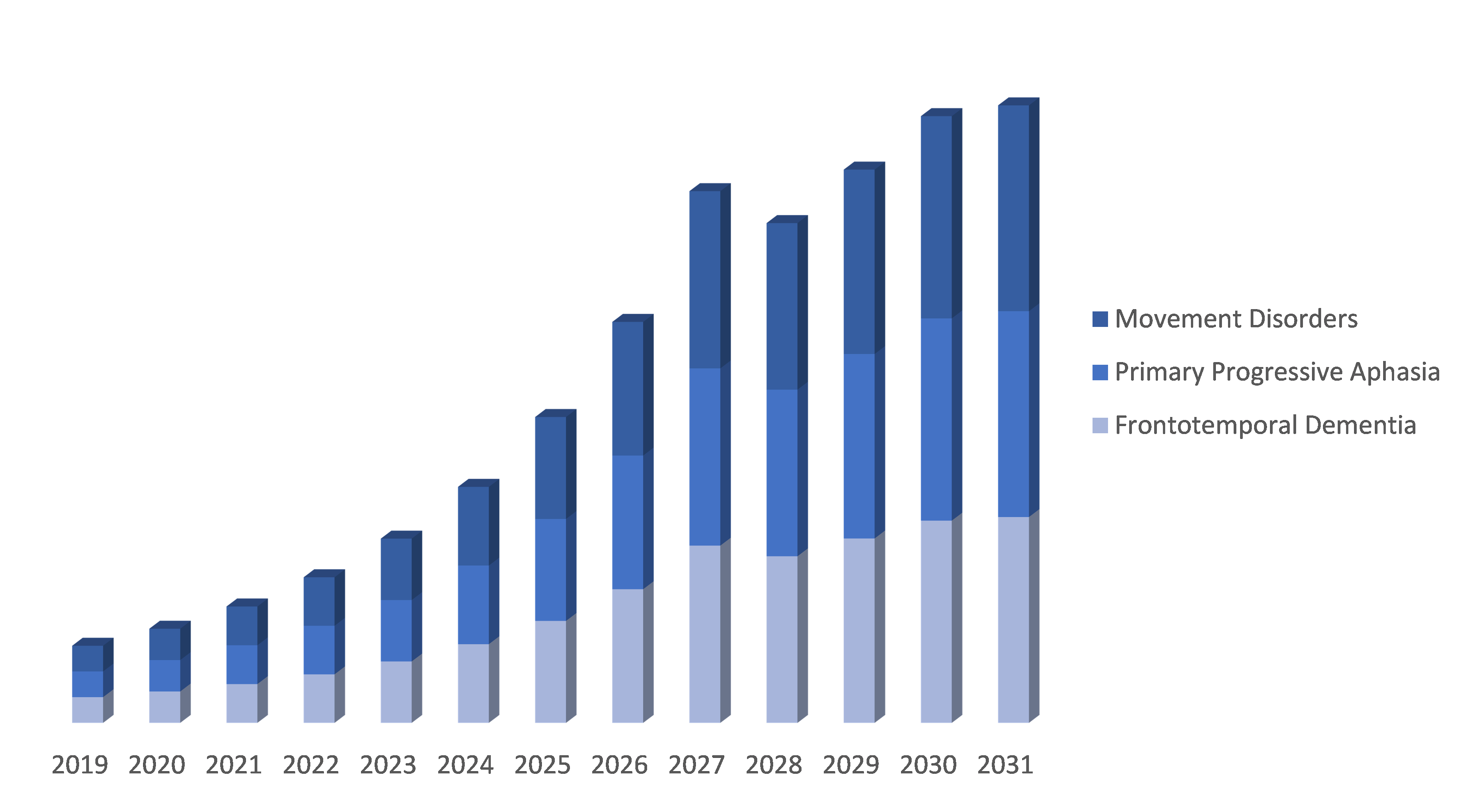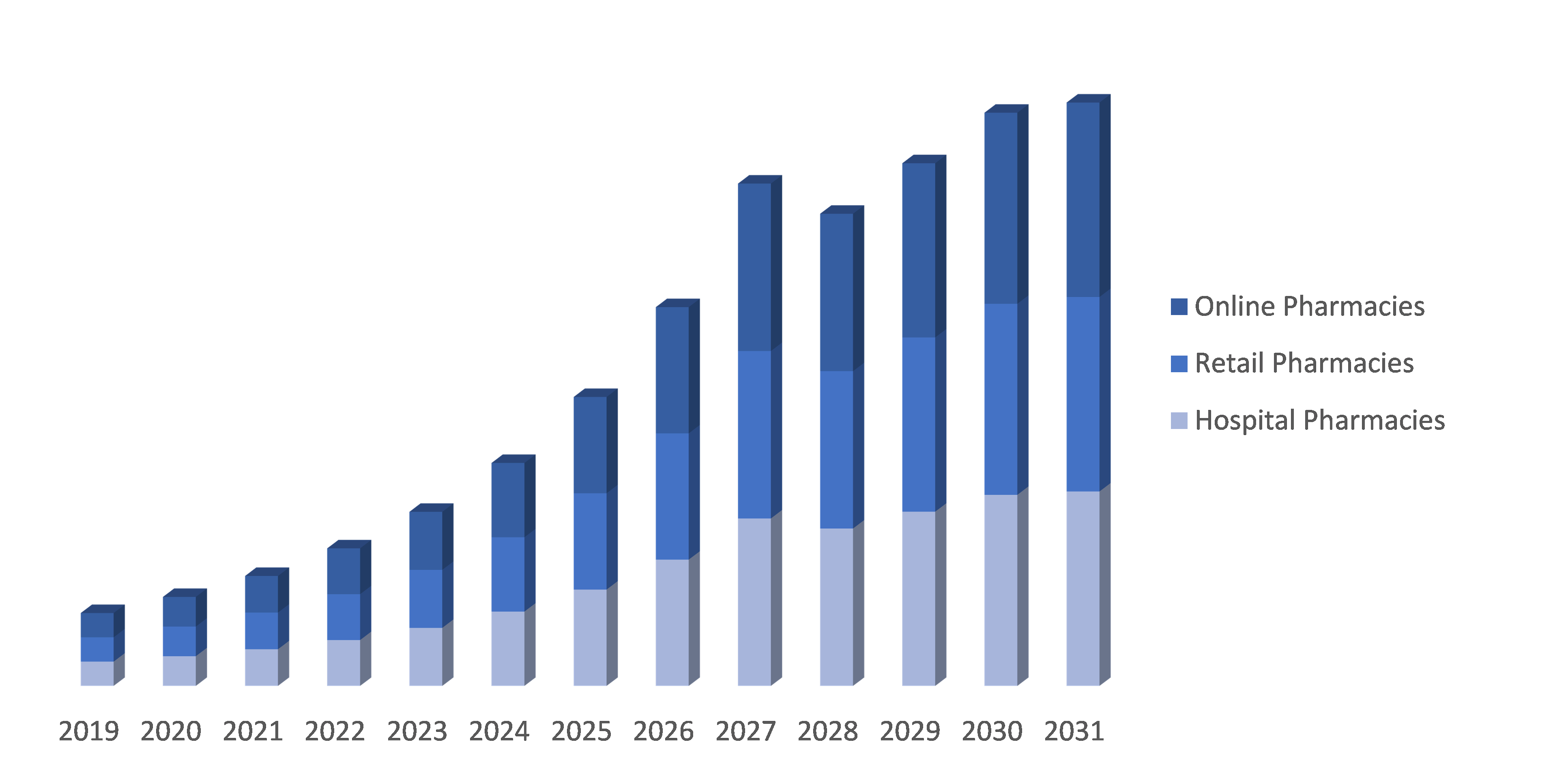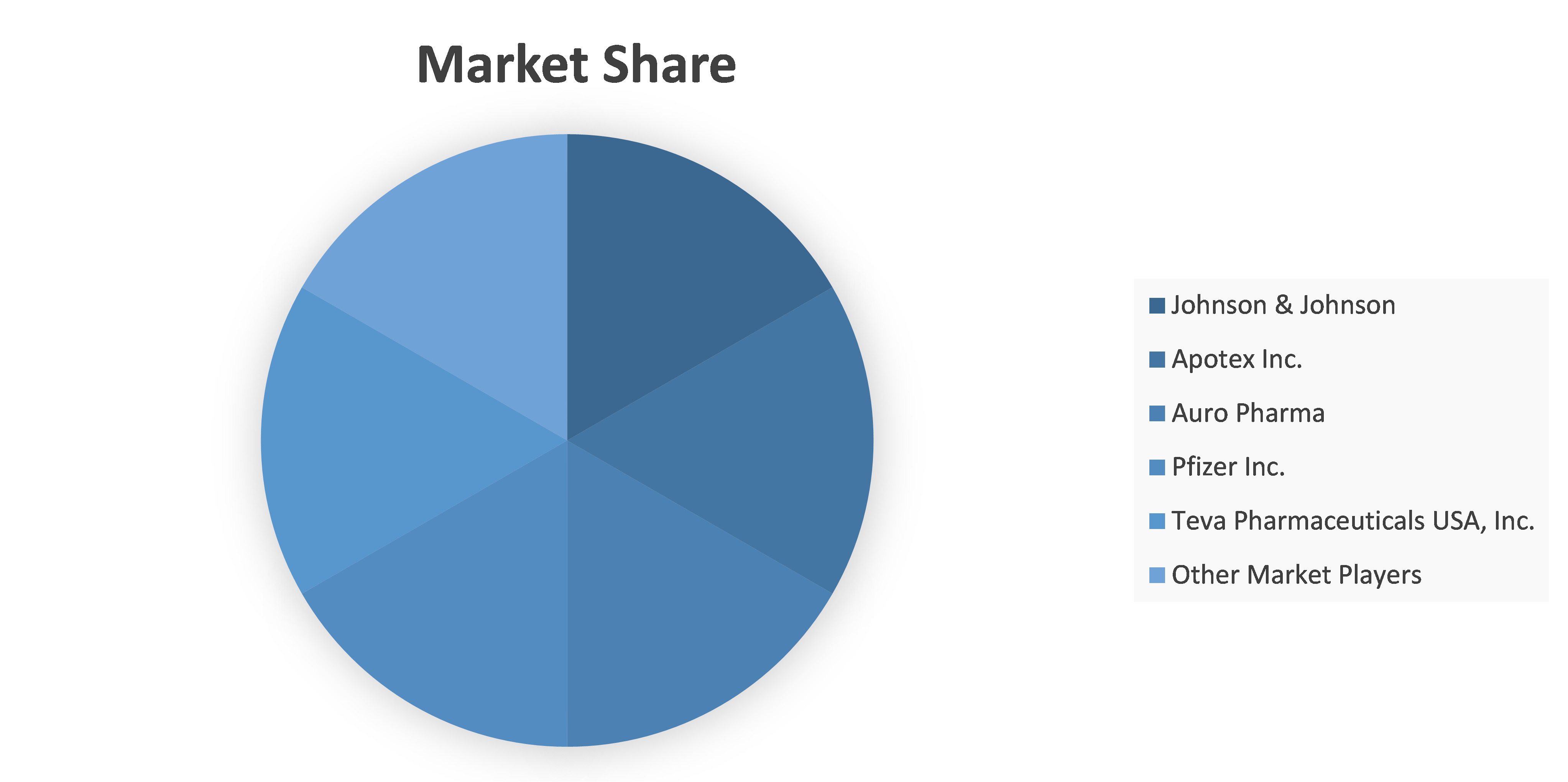- Home
- Frontotemporal Dementia Treatment Market

Frontotemporal Dementia Treatment Market Research Report 2023
- Published Date: May, 2023 | Report ID: CLS-1934 | No of pages: 250 | Format:

Frontotemporal Dementia Treatment Market by Drug Class (Cognitive Enhancers, Antipsychotics, Antidepressants, CNS Stimulants and Other Drug Classes), by Disease Indication (Frontotemporal Dementia, Primary Progressive Aphasia and Movement Disorders), by Distribution Channel (Hospital Pharmacies, Retail Pharmacies and Online Pharmacies): Global Opportunity Analysis and Industry Forecast, 2022-2031
The Frontotemporal Dementia Treatment market was valued at $315 million in 2022. It is projected to grow at a CAGR of 4.5% from 2023 to 2031 and reach more than $450 million by the end of 2031
Analysts’ Viewpoint by Cognate Lifesciences
The Frontotemporal Dementia Treatment market is expected to grow significantly in the coming years, driven by an increase in the prevalence of frontotemporal dementia and a growing aging population. Currently, there are no FDA-approved drugs specifically for the treatment of FTD, and the available treatments are mainly aimed at managing symptoms.
However, there are several drugs in the pipeline that show promise in treating FTD. For example, some drugs are being developed that target the accumulation of abnormal proteins in the brain, which is a hallmark of FTD. Additionally, researchers are exploring the use of gene therapies and stem cell therapies to treat FTD. The market for FTD treatments is also being driven by increasing research and development activities and rising investment in the healthcare sector. However, there are several challenges that could hinder the growth of the market, including high costs associated with drug development and regulatory hurdles.
Overall, the Frontotemporal Dementia Treatment market is expected to grow in the coming years as more effective treatments become available. However, it will require significant investment in research and development to develop and commercialize these treatments.
Frontotemporal Dementia Treatment Overview
Frontotemporal dementia (FTD) is a complex disease that affects the brain's frontal and temporal lobes, resulting in changes in behavior, personality, and language abilities. There is currently no cure for FTD, but there are several treatments available that can help manage symptoms and improve quality of life for patients. The treatment of FTD is typically focused on managing behavioral and cognitive symptoms. This may involve medications such as antidepressants, antipsychotics, and mood stabilizers to manage behavioral symptoms like agitation, aggression, and depression.
FTD is a rare disease, but its prevalence is expected to increase in the coming years due to the aging population. As the population ages, the number of people living with FTD is expected to increase, which will drive demand for effective treatments. Currently, there are no FDA-approved drugs specifically for the treatment of FTD. This has created a significant unmet need, and there is growing demand for effective treatments that can help manage symptoms and improve quality of life for patients. This growing demand is driving investment in healthcare, particularly in research and development activities. The healthcare industry is experiencing significant growth, and increasing investment is enabling the development of new and innovative treatments for FTD.
Technological advancements in areas such as gene therapy, stem cell therapy, and imaging techniques are also driving the development of new and more effective treatments for FTD. These technological advancements are enabling researchers to better understand the underlying mechanisms of FTD, identify new therapeutic targets, and develop more targeted and personalized treatments. Governments around the world are recognizing the significant burden that FTD places on healthcare systems and are providing support for research and development activities. For example, the US National Institute on Aging and the Alzheimer’s Association have committed significant resources to research on FTD. Similarly, the European Union has launched several initiatives to support research on FTD and other neurodegenerative diseases.
The development of effective treatments for FTD is essential, as FTD has a significant impact on patients and their families. FTD can cause significant behavioral changes that can be challenging for caregivers, and there is currently no cure for the disease. However, new and innovative treatments are being developed that show promise in managing symptoms and improving quality of life for patients.
In conclusion, the increasing prevalence of FTD, growing demand for effective treatments, rising investment in healthcare, technological advancements, and government support are all driving the development of new and innovative treatments for FTD. Ongoing research and development in this area are essential to developing effective treatments for FTD and improving the lives of patients and their families.
New product launches to flourish in the market
The Frontotemporal Dementia Treatment market is expected to see several new product launches in the coming years, driven by increasing investment in research and development activities. Some of the key product launches expected in the Frontotemporal Dementia Treatment market are:
- AL001 is a monoclonal antibody being developed by Alector for the treatment of FTD. AL001 targets the progranulin protein, which is reduced in patients with FTD. A Phase 2 trial of AL001 is ongoing, and the results was expected in 2022.
- LMTX is a tau aggregation inhibitor being developed by TauRx Therapeutics for the treatment of FTD. LMTX targets the aggregation of tau protein, which is a hallmark of FTD. Phase 3 trials of LMTX have been completed, and the results are currently being analysed.
- BIIB076 is a monoclonal antibody being developed by Biogen for the treatment of FTD. BIIB076 targets the tau protein, which is involved in the pathology of FTD. Phase 1 trials of BIIB076 have been completed, and Phase 2 trials are ongoing.
- UB-311 is a peptide vaccine being developed by United Neuroscience for the treatment of FTD. UB-311 targets the amyloid beta protein, which is involved in the pathology of FTD. Phase 2 trials of UB-311 are ongoing.
Segment Overview:
By Drug Class: The Frontotemporal Dementia Treatment market is divided into Cognitive Enhancers, Antipsychotics, Antidepressants, CNS Stimulants and Other Drug Classes. Cognitive enhancers are used to improve memory, attention, and other cognitive functions. Antipsychotics are used to treat symptoms such as aggression and agitation. Antidepressants are used to treat mood disorders, and CNS stimulants are used to improve alertness and attention. Other drug classes include drugs used to manage symptoms such as insomnia and anxiety.

By Disease Indication: The Frontotemporal Dementia Treatment market is segmented by Disease Indication, with Frontotemporal Dementia, Primary Progressive Aphasia and Movement Disorders. Frontotemporal Dementia is a neurodegenerative disease that affects the frontal and temporal lobes of the brain, leading to changes in personality, behavior, and language. Primary Progressive Aphasia is a subtype of FTD that primarily affects language functions. Movement disorders, such as corticobasal degeneration and progressive supranuclear palsy, can also be associated with FTD. Each of these disease indications requires specific treatment approaches.

By Distribution Channel: The Frontotemporal Dementia Treatment market is segmented by Hospital Pharmacies, Retail Pharmacies and Online Pharmacies. Hospital pharmacies provide medications to inpatients and outpatients receiving medical care in a hospital setting. Retail pharmacies dispense medications to patients for outpatient use. Online pharmacies offer the convenience of ordering medications online and having them delivered to the patient's home. The choice of distribution channel may depend on factors such as patient preference, convenience, and insurance coverage

By Region:
The North American Frontotemporal Dementia Treatment market is expected to see significant growth due to the increasing prevalence of FTD and rising demand for effective treatments. The presence of major pharmaceutical companies in the region, along with a strong focus on research and development, is driving innovation in FTD treatments. The United States is a major market in the region, with high healthcare spending and a large population of elderly individuals who are at greater risk of developing FTD. The availability of government support for research and development activities is also contributing to the growth of the market in North America.
The Asia Pacific (APAC) Frontotemporal Dementia Treatment market is expected to experience significant growth due to the rising prevalence of FTD and increasing demand for effective treatments. The large population in the region, particularly in countries such as China and India, is a major contributor to this growth. The region is also home to a growing number of pharmaceutical companies and research institutions, which are driving innovation in FTD treatments. The growing investment in healthcare infrastructure and rising healthcare spending in the region are also expected to contribute to the growth of the market. However, factors such as limited access to healthcare and low awareness of FTD may hinder market growth in some areas.

Competitive analysis and profiles of the major players in the Frontotemporal Dementia Treatment market, such as Pfizer Inc., Apotex Inc., AstraZeneca plc. Auro Pharma, Johnson & Johnson, Mylan N.V., Sanofi S.A., Teva Pharmaceuticals USA, Inc., among others. Major players have adopted product launch and acquisition as key developmental strategies to improve the product portfolio of the Frontotemporal Dementia Treatment market.
Market Scope and Structure Analysis
|
Report Metric |
Details |
|
Market Size Available for Years |
2021–2031 |
|
Base Year Considered |
2022 |
|
Forecast Period |
2023–2031 |
|
Forecast Unit |
Value (USD) |
|
Segments Covered |
By Drug Class, Disease Indication and End-user, and Region |
|
Regions Covered |
North America, Europe, Asia-Pacific, LAMEA |
|
Companies Covered |
|
Key Segments Covered
Drug Class
- Cognitive Enhancers
- Antipsychotics
- Antidepressants
- CNS Stimulants
- Other Drug Classes
Disease Indication
- Frontotemporal Dementia
- Primary Progressive Aphasia
- Movement Disorders
Distribution Channel
- Hospital Pharmacies
- Retail Pharmacies
- Online Pharmacies
Region
- North America
- U.S.
- Canada
- Mexico
- Europe
- Germany
- UK
- France
- Italy
- Spain
- Rest of Europe
- Asia-Pacific
- China
- Japan
- South Korea
- India
- Australia
- Rest of Asia-Pacific
- LAMEA
- Latin America
- Middle East
- Africa
TABLE OF CONTENT
- Research Methodology
- Desk Research
- Real-time insights and validation
- Forecast model
- Assumptions and forecast parameters
- Assumptions
- Forecast parameters
- Data sources
- Primary
- Secondary
- Executive Summary
- 360° summary
- By Drug Class trends
- By Disease Indication trends
- By Distribution Channel trends
- Market Overview
- Market segmentation & definitions
- Key takeaways
- Top investment pockets
- Top winning strategies
- Porter’s five forces analysis
- Bargaining power of consumers
- Bargaining power of suppliers
- Threat of new entrants
- Threat of substitutes
- Competitive rivalry in the market
- Market dynamics
- Drivers
- Restraints
- Opportunities
- Technology landscape
- Pipeline Analysis
- Regulatory landscape
- Patent landscape
- Market value chain analysis
- Strategic overview
- Frontotemporal Dementia Treatment Market, by Drug Class
- Cognitive Enhancers
- Market size and forecast, by region, 2022-2031
- Comparative market share analysis, 2022 & 2031
- Antipsychotics
- Market size and forecast, by region, 2022-2031
- Comparative market share analysis, 2022 & 2031
- Antidepressants
- Market size and forecast, by region, 2022-2031
- Comparative market share analysis, 2022 & 2031
- CNS Stimulants
- Market size and forecast, by region, 2022-2031
- Comparative market share analysis, 2022 & 2031
- Other Drug Classes
- Market size and forecast, by region, 2022-2031
- Comparative market share analysis, 2022 & 2031
- Cognitive Enhancers
- Frontotemporal Dementia Treatment Market, by Disease Indication
- Frontotemporal Dementia
- Market size and forecast, by region, 2022-2031
- Comparative market share analysis, 2022 & 2031
- Primary Progressive Aphasia
- Market size and forecast, by region, 2022-2031
- Comparative market share analysis, 2022 & 2031
- Movement Disorders
- Market size and forecast, by region, 2022-2031
- Comparative market share analysis, 2022 & 2031
- Frontotemporal Dementia
- Frontotemporal Dementia Treatment Market, by Distribution Channel
- Hospital Pharmacies
- Market size and forecast, by region, 2022-2031
- Comparative market share analysis, 2022 & 2031
- Retail Pharmacies
- Market size and forecast, by region, 2022-2031
- Comparative market share analysis, 2022 & 2031
- Online Pharmacies
- Market size and forecast, by region, 2022-2031
- Comparative market share analysis, 2022 & 2031
- Hospital Pharmacies
- Frontotemporal Dementia Treatment Market, by Region
- North America
- Market size and forecast, by Drug Class, 2022-2031
- Market size and forecast, by Disease Indication, 2022-2031
- Market size and forecast, by Distribution Channel, 2022-2031
- Market size and forecast, by country, 2022-2031
- Comparative market share analysis, 2022 & 2031
- U.S.
- Market size and forecast, by Drug Class, 2022-2031
- Market size and forecast, by Disease Indication, 2022-2031
- Market size and forecast, by Distribution Channel , 2022-2031
- Comparative market share analysis, 2022 & 2031
- Canada
- Market size and forecast, by Drug Class, 2022-2031
- Market size and forecast, by Disease Indication, 2022-2031
- Market size and forecast, by Distribution Channel , 2022-2031
- Comparative market share analysis, 2022 & 2031
- Mexico
- Market size and forecast, by Drug Class, 2022-2031
- Market size and forecast, by Disease Indication, 2022-2031
- Market size and forecast, by Distribution Channel , 2022-2031
- Comparative market share analysis, 2022 & 2031
- Europe
- Market size and forecast, by Drug Class, 2022-2031
- Market size and forecast, by Disease Indication, 2022-2031
- Market size and forecast, by Distribution Channel , 2022-2031
- Market size and forecast, by country, 2022-2031
- Comparative market share analysis, 2022 & 2031
- Germany
- Market size and forecast, by Drug Class, 2022-2031
- Market size and forecast, by Disease Indication, 2022-2031
- Market size and forecast, by Distribution Channel , 2022-2031
- Comparative market share analysis, 2022 & 2031
- UK
- Market size and forecast, by Drug Class, 2022-2031
- Market size and forecast, by Disease Indication, 2022-2031
- Market size and forecast, by Distribution Channel , 2022-2031
- Comparative market share analysis, 2022 & 2031
- France
- Market size and forecast, by Drug Class, 2022-2031
- Market size and forecast, by Disease Indication, 2022-2031
- Market size and forecast, by Distribution Channel , 2022-2031
- Comparative market share analysis, 2022 & 2031
- Spain
- Market size and forecast, by Drug Class, 2022-2031
- Market size and forecast, by Disease Indication, 2022-2031
- Market size and forecast, by Distribution Channel , 2022-2031
- Comparative market share analysis, 2022 & 2031
- Italy
- Market size and forecast, by Drug Class, 2022-2031
- Market size and forecast, by Disease Indication, 2022-2031
- Market size and forecast, by Distribution Channel , 2022-2031
- Comparative market share analysis, 2022 & 2031
- North America
-
-
- Rest of Europe
- Market size and forecast, by Drug Class, 2022-2031
- Market size and forecast, by Disease Indication, 2022-2031
- Market size and forecast, by Distribution Channel , 2022-2031
- Comparative market share analysis, 2022 & 2031
- Rest of Europe
- Asia Pacific
- Market size and forecast, by Drug Class, 2022-2031
- Market size and forecast, by Disease Indication, 2022-2031
- Market size and forecast, by Distribution Channel , 2022-2031
- Market size and forecast, by country, 2022-2031
- Comparative market share analysis, 2022 & 2031
- China
- Market size and forecast, by Drug Class, 2022-2031
- Market size and forecast, by Disease Indication, 2022-2031
- Market size and forecast, by Distribution Channel , 2022-2031
- Comparative market share analysis, 2022 & 2031
- India
- Market size and forecast, by Drug Class, 2022-2031
- Market size and forecast, by Disease Indication, 2022-2031
- Market size and forecast, by Distribution Channel , 2022-2031
- Comparative market share analysis, 2022 & 2031
- Australia
- Market size and forecast, by Drug Class, 2022-2031
- Market size and forecast, by Disease Indication, 2022-2031
- Market size and forecast, by Distribution Channel , 2022-2031
- Comparative market share analysis, 2022 & 2031
- Rest of Asia Pacific
- Market size and forecast, by Drug Class, 2022-2031
- Market size and forecast, by Disease Indication, 2022-2031
- Market size and forecast, by Distribution Channel , 2022-2031
- Comparative market share analysis, 2022 & 2031
- LAMEA
- Market size and forecast, by Drug Class, 2022-2031
- Market size and forecast, by Disease Indication, 2022-2031
- Market size and forecast, by Distribution Channel , 2022-2031
- Market size and forecast, by country, 2022-2031
- Comparative market share analysis, 2022 & 2031
- Latin America
- Market size and forecast, by Drug Class, 2022-2031
- Market size and forecast, by Disease Indication, 2022-2031
- Market size and forecast, by Distribution Channel , 2022-2031
- Comparative market share analysis, 2022 & 2031
- Middle East
- Market size and forecast, by Drug Class, 2022-2031
- Market size and forecast, by Disease Indication, 2022-2031
- Market size and forecast, by Distribution Channel , 2022-2031
- Comparative market share analysis, 2022 & 2031
- Africa
- Market size and forecast, by Drug Class, 2022-2031
- Market size and forecast, by Disease Indication, 2022-2031
- Market size and forecast, by Distribution Channel , 2022-2031
- Comparative market share analysis, 2022 & 2031
-
- Company profiles
- Johnson & Johnson
- Business overview
- Financial performance
- Drug Class portfolio
- Recent strategic moves & developments
- SWOT analysis
- Apotex Inc.
- Business overview
- Financial performance
- Drug Class portfolio
- Recent strategic moves & developments
- SWOT analysis
- Auro Pharma
- Business overview
- Financial performance
- Drug Class portfolio
- Recent strategic moves & developments
- SWOT analysis
- Pfizer Inc.
- Business overview
- Financial performance
- Drug Class portfolio
- Recent strategic moves & developments
- SWOT analysis
- Teva Pharmaceuticals USA, Inc.
- Business overview
- Financial performance
- Drug Class portfolio
- Recent strategic moves & developments
- SWOT analysis
- Other Prominent Players
- Business overview
- Financial performance
- Drug Class portfolio
- Recent strategic moves & developments
- SWOT analysis
- Johnson & Johnson
Segmentation
Key Segments Covered
Drug Class
- Cognitive Enhancers
- Antipsychotics
- Antidepressants
- CNS Stimulants
- Other Drug Classes
Disease Indication
- Frontotemporal Dementia
- Primary Progressive Aphasia
- Movement Disorders
Distribution Channel
- Hospital Pharmacies
- Retail Pharmacies
- Online Pharmacies
Region
- North America
- U.S.
- Canada
- Mexico
- Europe
- Germany
- UK
- France
- Italy
- Spain
- Rest of Europe
- Asia-Pacific
- China
- Japan
- South Korea
- India
- Australia
- Rest of Asia-Pacific
- LAMEA
- Latin America
- Middle East
- Africa
Methodology
Get your pre and post sales queries resolved by our Subject matter experts.
We will assist you to customize the report to fit your research needs.
Our prime focus is to provide qualitative and accurate data.
Feel free to order a sample report before purchase.
Your personal and confidential information is safe and secured.
© 2025 Cognate Lifesciences. All Rights Reserved.
